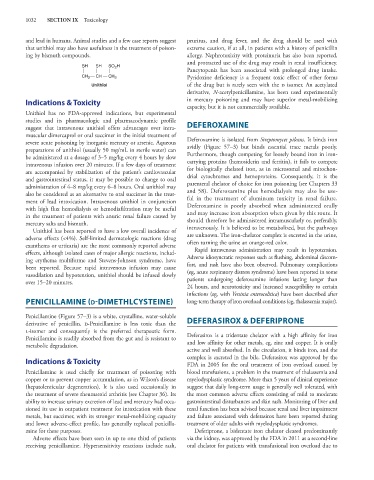Page 1046 - Basic _ Clinical Pharmacology ( PDFDrive )
P. 1046
1032 SECTION IX Toxicology
and lead in humans. Animal studies and a few case reports suggest pruritus, and drug fever, and the drug should be used with
that unithiol may also have usefulness in the treatment of poison- extreme caution, if at all, in patients with a history of penicillin
ing by bismuth compounds. allergy. Nephrotoxicity with proteinuria has also been reported,
and protracted use of the drug may result in renal insufficiency.
SH SH SO 2 H
Pancytopenia has been associated with prolonged drug intake.
CH 2 CH CH 2 Pyridoxine deficiency is a frequent toxic effect of other forms
Unithiol of the drug but is rarely seen with the d isomer. An acetylated
derivative, N-acetylpenicillamine, has been used experimentally
Indications & Toxicity in mercury poisoning and may have superior metal-mobilizing
capacity, but it is not commercially available.
Unithiol has no FDA-approved indications, but experimental
studies and its pharmacologic and pharmacodynamic profile DEFEROXAMINE
suggest that intravenous unithiol offers advantages over intra-
muscular dimercaprol or oral succimer in the initial treatment of
severe acute poisoning by inorganic mercury or arsenic. Aqueous Deferoxamine is isolated from Streptomyces pilosus. It binds iron
preparations of unithiol (usually 50 mg/mL in sterile water) can avidly (Figure 57–3) but binds essential trace metals poorly.
be administered at a dosage of 3–5 mg/kg every 4 hours by slow Furthermore, though competing for loosely bound iron in iron-
intravenous infusion over 20 minutes. If a few days of treatment carrying proteins (hemosiderin and ferritin), it fails to compete
are accompanied by stabilization of the patient’s cardiovascular for biologically chelated iron, as in microsomal and mitochon-
and gastrointestinal status, it may be possible to change to oral drial cytochromes and hemoproteins. Consequently, it is the
administration of 4–8 mg/kg every 6–8 hours. Oral unithiol may parenteral chelator of choice for iron poisoning (see Chapters 33
also be considered as an alternative to oral succimer in the treat- and 58). Deferoxamine plus hemodialysis may also be use-
ment of lead intoxication. Intravenous unithiol in conjunction ful in the treatment of aluminum toxicity in renal failure.
with high flux hemodialysis or hemodiafiltration may be useful Deferoxamine is poorly absorbed when administered orally
in the treatment of patients with anuric renal failure caused by and may increase iron absorption when given by this route. It
mercury salts and bismuth. should therefore be administered intramuscularly or, preferably,
Unithiol has been reported to have a low overall incidence of intravenously. It is believed to be metabolized, but the pathways
adverse effects (<4%). Self-limited dermatologic reactions (drug are unknown. The iron-chelator complex is excreted in the urine,
exanthems or urticaria) are the most commonly reported adverse often turning the urine an orange-red color.
effects, although isolated cases of major allergic reactions, includ- Rapid intravenous administration may result in hypotension.
ing erythema multiforme and Stevens-Johnson syndrome, have Adverse idiosyncratic responses such as flushing, abdominal discom-
been reported. Because rapid intravenous infusion may cause fort, and rash have also been observed. Pulmonary complications
vasodilation and hypotension, unithiol should be infused slowly (eg, acute respiratory distress syndrome) have been reported in some
over 15–20 minutes. patients undergoing deferoxamine infusions lasting longer than
24 hours, and neurotoxicity and increased susceptibility to certain
infections (eg, with Yersinia enterocolitica) have been described after
PENICILLAMINE (d-DIMETHLCYSTEINE) long-term therapy of iron overload conditions (eg, thalassemia major).
Penicillamine (Figure 57–3) is a white, crystalline, water-soluble
derivative of penicillin. d-Penicillamine is less toxic than the DEFERASIROX & DEFERIPRONE
l-isomer and consequently is the preferred therapeutic form.
Penicillamine is readily absorbed from the gut and is resistant to Deferasirox is a tridentate chelator with a high affinity for iron
metabolic degradation. and low affinity for other metals, eg, zinc and copper. It is orally
active and well absorbed. In the circulation, it binds iron, and the
Indications & Toxicity complex is excreted in the bile. Deferasirox was approved by the
FDA in 2005 for the oral treatment of iron overload caused by
Penicillamine is used chiefly for treatment of poisoning with blood transfusions, a problem in the treatment of thalassemia and
copper or to prevent copper accumulation, as in Wilson’s disease myelodysplastic syndrome. More than 5 years of clinical experience
(hepatolenticular degeneration). It is also used occasionally in suggest that daily long-term usage is generally well tolerated, with
the treatment of severe rheumatoid arthritis (see Chapter 36). Its the most common adverse effects consisting of mild to moderate
ability to increase urinary excretion of lead and mercury had occa- gastrointestinal disturbances and skin rash. Monitoring of liver and
sioned its use in outpatient treatment for intoxication with these renal function has been advised because renal and liver impairment
metals, but succimer, with its stronger metal-mobilizing capacity and failure associated with deferasirox have been reported during
and lower adverse-effect profile, has generally replaced penicilla- treatment of older adults with myelodysplastic syndromes.
mine for these purposes. Deferiprone, a bidentate iron chelator cleared predominantly
Adverse effects have been seen in up to one third of patients via the kidney, was approved by the FDA in 2011 as a second-line
receiving penicillamine. Hypersensitivity reactions include rash, oral chelator for patients with transfusional iron overload due to

